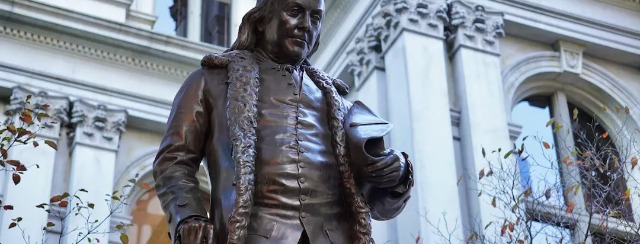Enjoy this Free Freedom Trail Boston Tour
At this time of year, I can’t help but think about New England and particularly Boston. I first visited last year and spent a day discovering the city and drinking far too many vanilla lattes. So, on my most recent trip to Boston, last summer I was keen to explore more of the city. Especially the Freedom Trail, which I’d only walked a portion of last time, and really wanted to discover more of Boston’s rich history. The Freedom Trail is a 2-and-a-half-mile brick path. There are 16 historic sites along the trail.
Boston’s Freedom Trail is an excellent way to get an overview of Boston’s historical sites and to see downtown Boston on the cheap any time of the year. The Freedom Trail is a red-brick path that leads pedestrians throughout Boston’s downtown core to some of its major historical buildings and not-to-be-missed sites.
The trail can be experienced as a self-guided tour using one of the many travel guidebooks available from your local bookstore, or you can purchase a ticket for a more formal group tour. The 90-minute tours run daily year-round and are led by energetic guides often costumed in historical garb. Tickets can be purchased at the Boston Common Visitor Information Centre or at the Bostix Booth in Faneuil Hall.
Though you can start walking the Freedom Trail at any point along the way, the official starting point is just outside the Visitor Information Centre in the Boston Common.
Sites along the Boston Freedom Trail
My initial plan was to find the end of the Trail, on Boston Common, and then follow the 2.5 miles it weaves through the City. However, upon arrival at Boston Common a tour was just about to start, rather than do all the hard work myself I joined the tour and it turned out to be the best decision. Led by Private George Osbourne (who stayed in character for the whole tour) we spent over two hours walking the streets of Boston following the red brick trial and discovering its secrets. Here are some of the historic sites we visited:
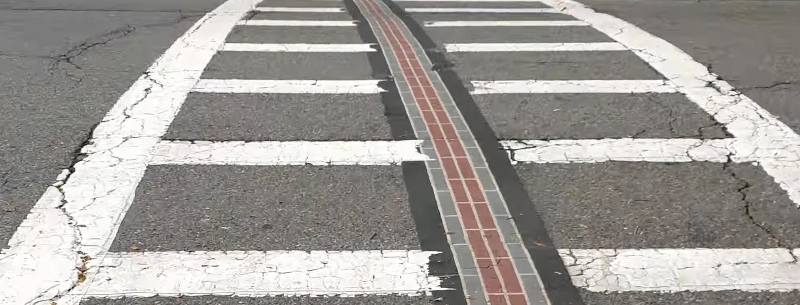
The Boston Freedom Trail is a historically significant stroll through the trailblazing stories of our nation’s struggle for freedom. Spanning 2.5 miles, this self-guided journey features sixteen sites that showcase the birthplace of the American Revolution.

There are 16 historical stops along the 2.5-mile-long Freedom Trail, including everything from government buildings to chapels and cemeteries, to historically important homes, stores, and battle sites. Here is a selection of what you’ll see:
The Boston Common
Boston Common was established in 1634 when Puritan colonists purchased the 44 acres from William Blackstone, who was a settler from Stratford upon Avon, Warwickshire, England, and the land became common ground. In the past, it was also a burial site where some 400 people were hanged.
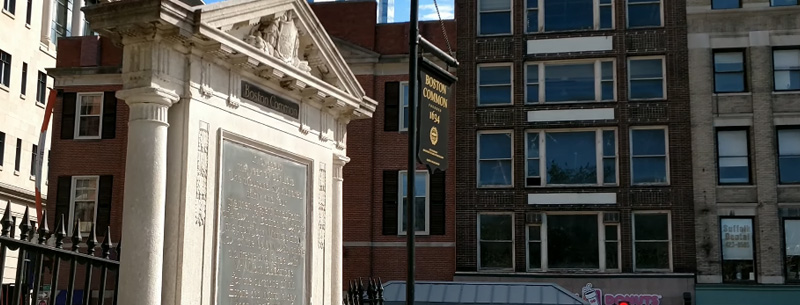
A large public park, the Boston Common is the oldest such park in America and has been witness to everything from grazing herds to public speeches, military training, and even gallows and hangings. Today it is a lush green refuge in central Boston and host to concerts and public celebrations
Dating back to 1634, the Common is the oldest landscaped public park in America – and the perfect place to begin exploring the Boston Freedom Trail. As you walk the path that winds around the park, it’s easy to imagine how our Founding Fathers felt as they strode along this ground. Not only has the Common served as an important gathering place for centuries, but it also served as the site of speeches, political protests, rallies, and more over time.

Situated across from the Massachusetts State House and Beacon Hill neighborhood, the Boston Common anchors both the cityscape and its long-held history. It features a host of educational opportunities, including historic statues and monuments, which tell the story of America’s struggle for independence. Here visitors can pay their respects to people like George Washington, Robert Gould Shaw, and his 54th Regiment, Samuel Adams, and Paul Revere.
The Common also stands witness to moral milestones such as the first reading of the Declaration of Independence in July 1776 and Martin Luther King Jr.’s 1968 speech on colonialism. Standing here today, it’s easy to understand why the sights and sounds of this special place are integral to American history.
Granary Burying Ground
The Granary burying ground is just up the street from Park Street Church. It is the third oldest graveyard, in Boston, and used to be part of Boston Common. It is the resting place of some of Boston’s most famous people. Including John Hancock, Benjamin Franklin’s parents, Paul Revere, Samuel Adams, as well as Robert Treat Paine, three of the people who signed the Declaration of Independence. There were some 8-10 thousand people buried in the graveyard and in 1850 the layout was changed and only the headstones were moved, not the tombs.
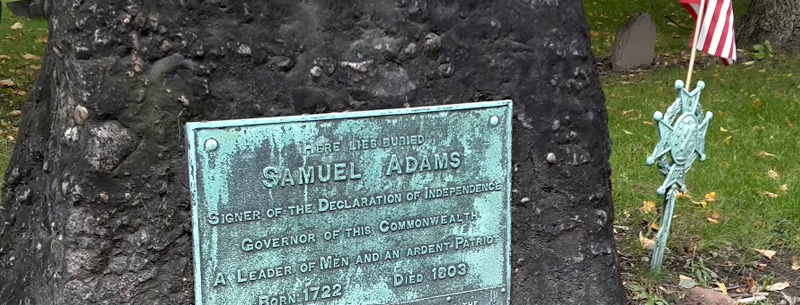
This final resting place of some of Boston’s most famous people evokes both the historical significance of the region and the simple beauty of the seasons in the northeast US. Among the 2,300 burial markers on the grounds, you’ll want to keep a lookout for those of important historical figures like Paul Revere, Samuel Adams, James Otis, Benjamin Franklin’s parents, Peter Faneuil and John Hancock.
Established in 1660, the Granary Burying Ground holds a rich history as it houses graves of some of America’s most influential and iconic figures like Paul Revere, Samuel Adams, John Hancock, Mother Goose, and others. This 2.5-acre plot of land managed by the City of Boston is highly sought after for its historical significance and serves as an important reminder of the many lives lost during the American Revolution.
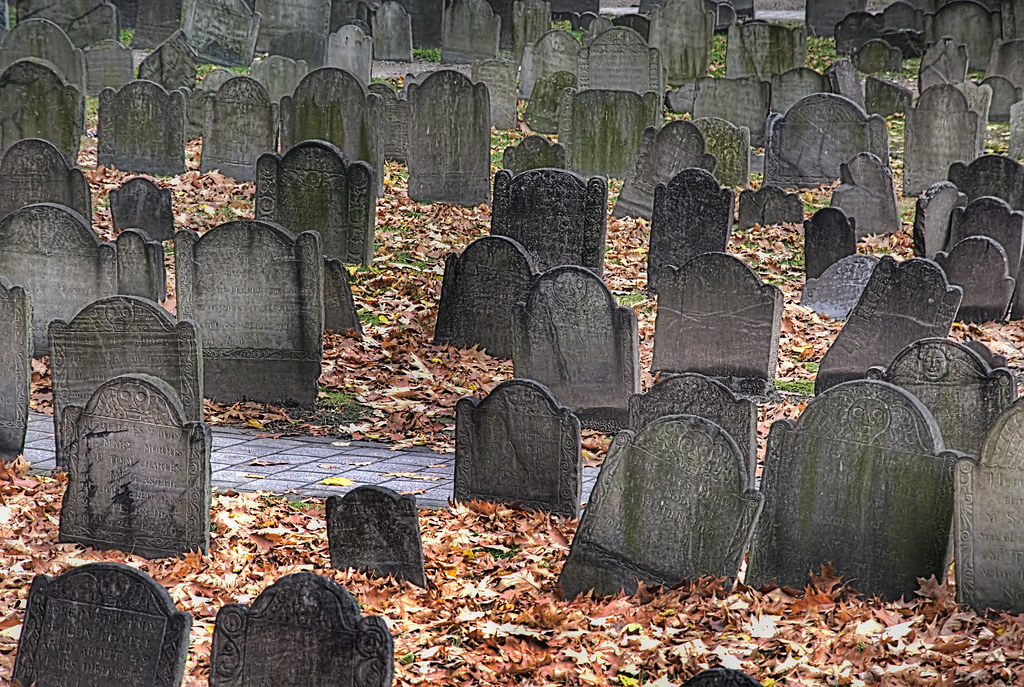
Visitors taking a guided tour of this site can also learn about the various headstones and monuments scattered across the grounds that serve as memorials to these fallen heroes. Furthermore, the old stones here are a great source of architectural information about Boston in the early days. For all these reasons and more, the Granary Burying Ground is a wonderful site to visit when exploring the history of Boston’s famous Freedom Trail.
Faneuil Hall
Faneuil Hall is a marketplace and meeting hall located near the waterfront and today’s Government Center, in Boston, Massachusetts. Opened in 1743, it was the site of several speeches by Samuel Adams, James Otis, and others encouraging independence from Great Britain. It is now part of Boston National Historical Park and a well-known stop on the Freedom Trail. It is sometimes referred to as “the Cradle of Liberty”.
Faneuil Hall is a symbol of the struggle for freedom in Boston. The site of the first town hall meeting in America, Faneuil Hall witnessed both debates and dissent in its 250 years as a meeting hall and marketplace. Currently, the location of a variety of retail stores and the Quincy Market, Faneuil Hall is a good place to stop for lunch and a little shopping. With restaurants and outdoor patios lining the pedestrian mall, there are many spots to sit and watch the passers-by. Or, venture into the Quincy Market for a wide selection of food-court-style eateries.
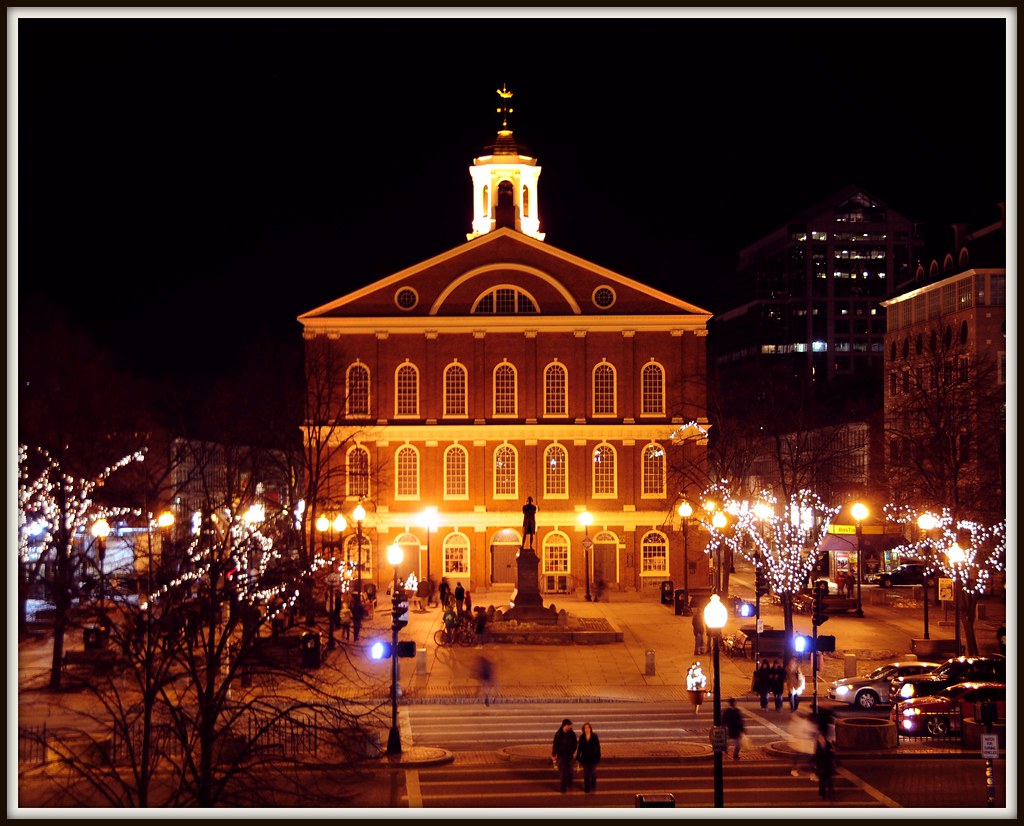
Faneuil Hall remains the home of democracy and justice in Boston. Inside its walls lies a meeting hall where citizens can exercise their right to free speech and share ideas with one another. Furthermore, visitors can explore the nearby Quincy Market, which offers a plethora of shops and eateries to satisfy all tastes. As you walk around Faneu10il Hall, take a moment to appreciate this stunning landmark and reflect on its long-standing role in Boston’s history.
King’s Chapel and Burying Ground
King’s Chapel Burying Ground is the oldest cemetery in Boston and is the burial site to numerous Puritan graves and tombs. Puritan Governor John Winthrop, Mayflower Passenger Mary Chilton, and Patriot William Dawes are all buried here. King’s Chapel was the first Anglican Church of England in the colonies, constructed in 1688. The original structure was destroyed by fire in 1711, but it was rebuilt in the same style soon after. The church is known not only for its exquisite interior architecture, but also for its iconic bell tower, which houses one of the oldest bells in North America.
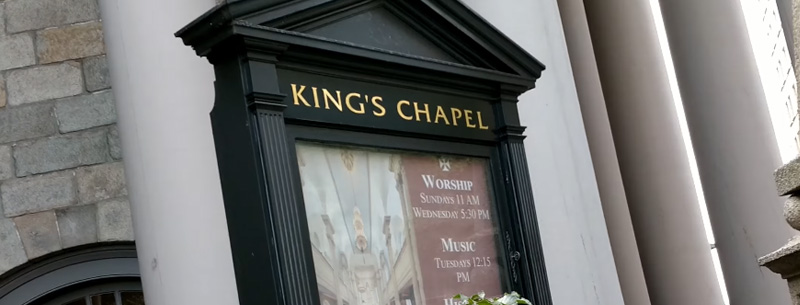
The adjoining burying ground offers visitors a glimpse into Boston’s past, providing an up-close view of headstones from the 1700s. Many of the tombstones offer an intriguing look at Colonial life, as several famous historical figures are laid to rest here, including Mary Chilton, who was one of the first settlers of Plymouth Colony.
Visiting King’s Chapel and Burying Ground is not only an opportunity to bask in the grandeur of this magnificent building, but also a chance to honor the memory of those who have come before us. Having gone through centuries of changes, this site continues to serve as a reminder of our shared history and a celebration of where we have been and what America stands for today.
Paul Revere House
It was Paul Revere’s home in 1775 when Revere set out on horseback to warn Boston’s leaders about the pending British attack. Today it is a museum commemorating one of Boston’s most famous sons.
The house was built around 1680 and owned by the silversmith Paul Revere from 1770 to 1800. Visitors to this remarkable structure can learn about the life of Revere and his role in the Revolutionary War.
Paul Revere’s house is very small, but then houses used to be. Built in 1680 the house is still standing today and you are able to take tours inside. Revere was a French man whose trade was a goldsmith and blacksmith, as well as being a grave master. He knew everything and also knew everyone’s business.
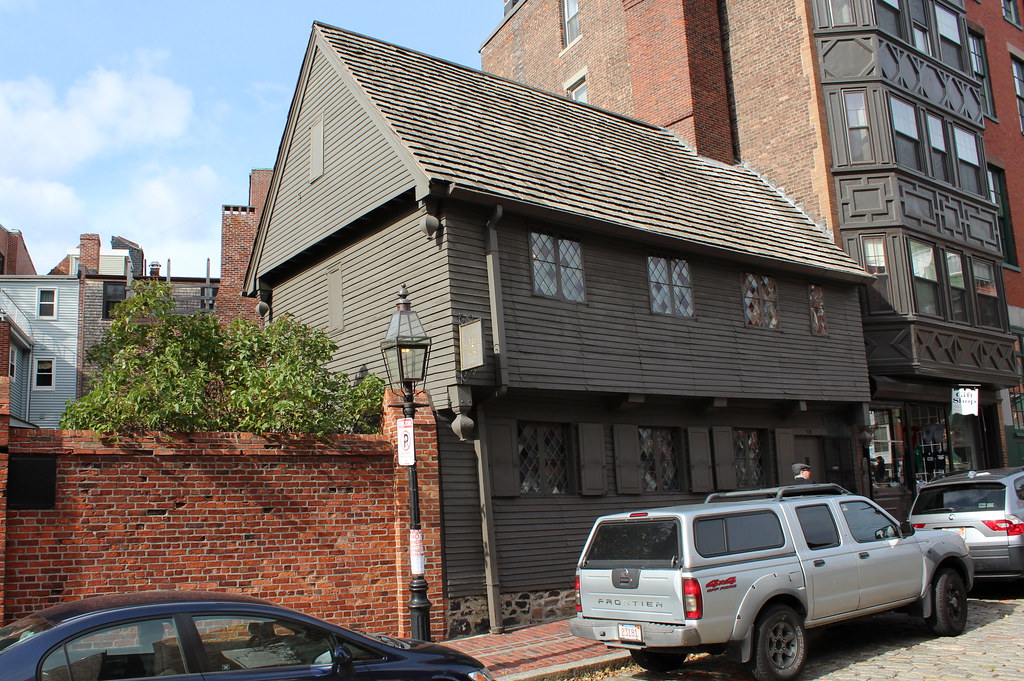
The two-story colonial house has been meticulously preserved and features many original furnishings. This includes Revere’s dining room table set, several pieces of furniture made by him, as well as numerous items he used in his silver-smithing business. An explanatory plaque on the side of the house highlights the legacy of one of America’s Founding Fathers and educates visitors about the events leading up to the American Revolution.
The Paul Revere House offers a fascinating look into the daily life of an 18th-century craftsman and patriot. In addition to its historical significance, the house provides an enriching educational experience for both adults and children. For those interested in American history, visiting this landmark is a must.
Benjamin Franklin statue & Boston Latin School
Boston’s oldest public school was founded in 1635 and a statue of Benjamin Franklin marks the spot where the original Boston Latin Schoolhouse was completed in 1645. All of the four who signed the Declaration of Independence, including Franklin, attended the school.
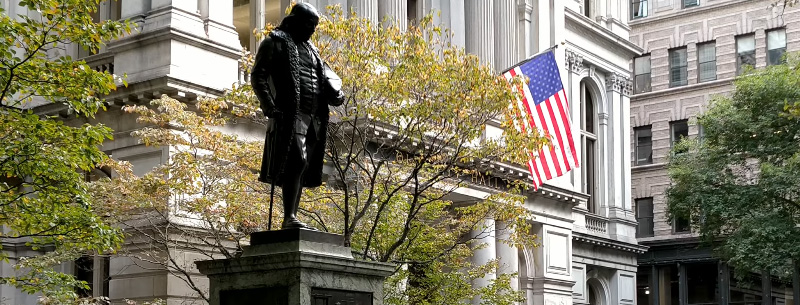
The statue stands as an enduring symbol of the spirit of freedom that has long characterized the city of Boston. It serves to remind us of Benjamin Franklin’s admirable commitment to justice, equality, and liberty. Of course, it’s also a reminder of the commendable work done by teachers and students at Boston Latin School for decades, having been founded in 1635 and making it the oldest school still in operation in the country. While we marvel at Benjamin Franklin’s continued influence even centuries after his life, we can also celebrate the contributions of those who continue to uphold our founding principles today.
Site of the Boston Massacre
Before the Old State House in downtown Boston, there is a large and prominent marker to commemorate the precise location where the so-called Boston Massacre took place. The wording and design of the memorial leave no doubt in the viewer’s mind: that they are standing on the very precise ground where a momentous historical event had occurred.
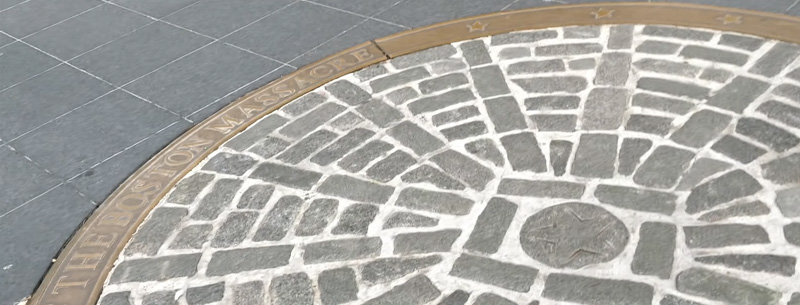
The site is located at the corner of State Street and Congress Street, near the Old State House. Today, visitors can view a circle of cobblestones marking the center of the Massacre scene and an eight-foot-high granite obelisk honoring those killed and injured. The monument is inscribed with the names of Crispus Attucks, Samuel Gray, James Caldwell, Samuel Maverick, Patrick Carr, and Christopher Monk – all victims of the tragedy. There is also a bronze statue depicting Captain Thomas Preston, the leader of the British Troops on that fateful day.
Visitors to the site can learn more about the Massacre by watching the short video presented inside the adjacent Visitors Center or by reading the interpretive panels detailing the events as they unfolded.
Massachusetts State House
Built in the early 1800s by Colonel Charles Bulfinch, the home of state government offers guided tours of its neoclassical facade and many beautiful artifacts within. Notable exhibits include a marble bust of John Adams, a bronze statue of Abraham Lincoln, and numerous historical documents that chronicle the state’s transformation over the centuries.
The Massachusetts State House, also known as the Massachusetts Statehouse or the “New” State House, is the state capitol and house of government of the Commonwealth of Massachusetts, located in the Beacon Hill neighborhood of Boston.
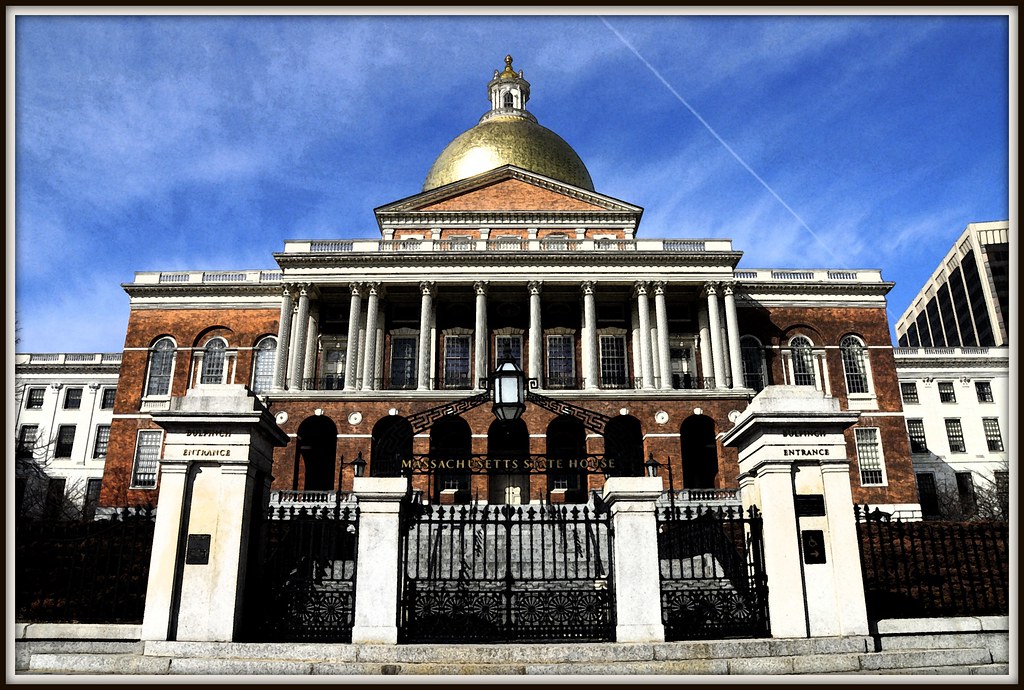
Located at the top of Beacon Hill, this elegant building has been the home of the Commonwealth of Massachusetts’ government since 1798. Its iconic gilded dome, which stands nearly 200 feet tall, has come to symbolize not only the state’s commitment to freedom and independence but also its architectural excellence.
Inside, visitors have the chance to view several art pieces and artifacts that illustrate the history of the state. The Grand Staircase is especially impressive, with its intricate murals depicting scenes from the American Revolution. Other highlights include a mural depicting George Washington leading troops into battle and John Adams’s desk, which can be found in his original office. With so many fascinating sights to discover, the Massachusetts State House is an essential destination for those looking to explore the roots of American liberty.
Old Corner Bookstore
Old Corner Bookstore is one of the oldest buildings in Boston. In 1712, the bookstore was known as the Crease House. During the time of religious freedom, a Puritan religious leader named Anne Hutchinson resided here and gave daily scripture readings. The building burned in 1711 and in 1828 Timothy Carter opened the bookstore and in 1832 William Ticknor added Publishing to the site. In the mid-1800s it was the center of American publishing. Today the bookstore is a Chipotle.
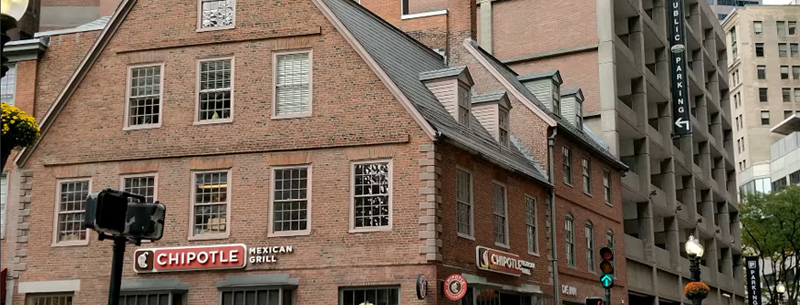
It served as a well-known gathering place for the city’s intellectuals and was once home to some of America’s most distinguished writers such as Louisa May Alcott, Ralph Waldo Emerson, and Henry David Thoreau. Visitors can take a guided tour of the bookstore or explore it on their own, getting a glimpse into one of the most important locations in Boston’s rich historical landscape.
Old South Meeting House
Since the 1773 mass protest meetings that led up to the Boston Tea Party, the Old South Meeting House has served as a gathering place for discussion and celebration and a haven for free speech.
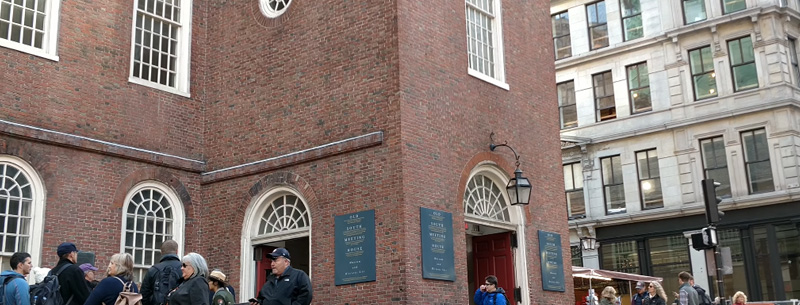
Once home to spirited debates over taxation and other political issues, the Old South Meeting House is now a museum dedicated to interpreting Boston’s role in the Revolutionary War era. Here, visitors can get an up-close look at religious artifacts, original furniture from the 1790s, and artifacts like drums used by soldiers in battle.

Founded in 1729, it served as a gathering place for the Colonial townspeople to discuss current events and politics. This was an important site for the Revolutionary War – it was here that the Boston Tea Party protest was launched, leaving an indelible mark in American history. Today, visitors to the Old South Meeting House can take a self-guided tour of the museum, view the cemetery honoring the fallen soldiers, or attend a live re-enactment. Whether you’re interested in learning more about our nation’s early beginnings or just enjoying its picturesque architecture, this is a must-visit destination for anyone interested in exploring America’s past.
Bunker Hill Monument
Breed’s Hill, the site of the Battle of Bunker Hill is in Charlestown, Massachusetts. It marks the location where the first offensive military action by the Colonists took place on June 17, 1775. r. The battle is named after the adjacent Bunker Hill, which was peripherally involved in the battle and was the original objective of both colonial and British troops, and is occasionally referred to as the “Battle of Breed’s Hill.”
This granite obelisk was erected in memory of the brave patriots who fought for freedom in the Battle of Bunker Hill on June 17th, 1775. Standing 221 feet tall, this monument serves as an enduring tribute to those who paid the ultimate price for America’s independence.
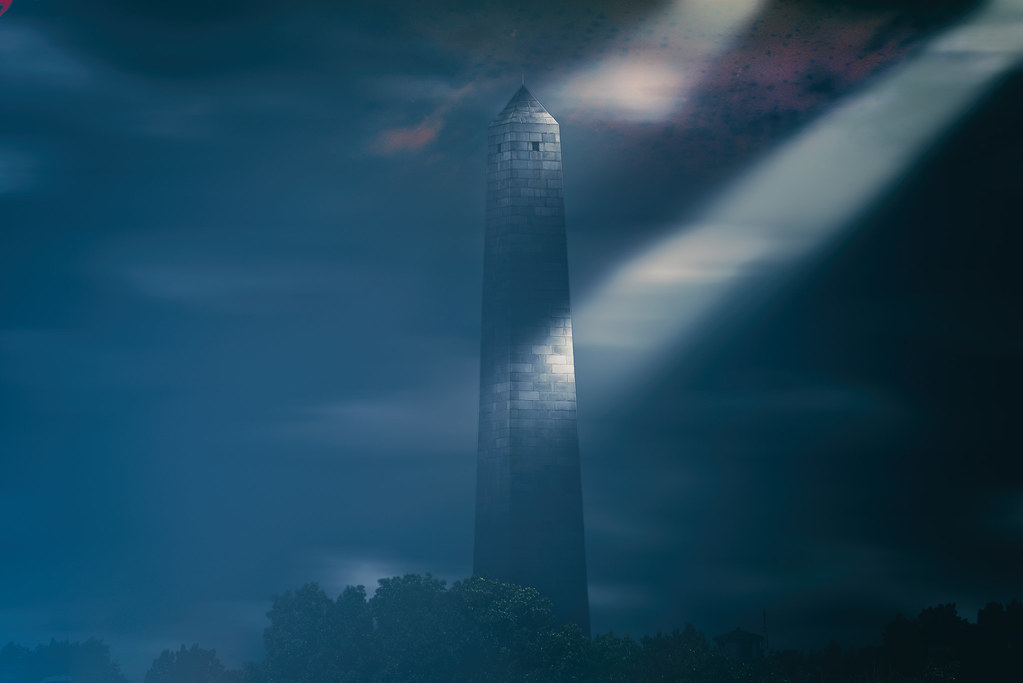
The Battle of Bunker Hill marks a significant moment in American history, as it was the first major victory for the newly formed Continental Army. Visitors can climb to the top of the monument and take in breathtaking views of the surrounding area. The monument is also surrounded by historical markers and plaques that provide more information about the battle and the men who fought there. The site offers an excellent opportunity to learn about some of America’s defining moments and gain a better understanding of what it meant to be a patriot during this time.
Old North Church
This National Historic Landmark is the country’s oldest standing church and famously acted as a beacon during Paul Revere’s famous midnight ride in 1775. The building itself is distinguished by its 18th-century spire and Georgian-style architecture, and it remains an important symbol of colonial America today.

Today, Old North Church continues to be a popular tourist destination for visitors wishing to learn about the history of the American Revolution. Inside, visitors can explore the historic building and view historical artifacts such as a portrait of George Washington as well as a Bible owned by John Hancock.
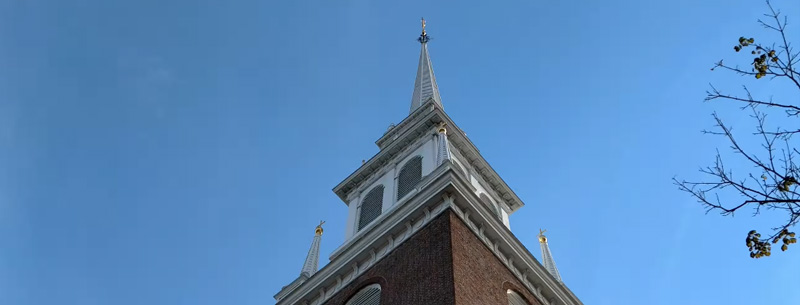
The outside features a number of monuments, including a statue of Paul Revere and a plaque commemorating the “Midnight Ride” event. Old North Church is also the site of many annual re-enactments of the iconic ride. If you’re looking for a truly unique way to experience Boston’s rich Revolutionary history, be sure to make a stop at Old North Church on your tour of the Freedom Trail.
Park Street Church
Park Street Church is one of the most historic churches in Boston having seen prison reform started in the church, the women’s suffrage movement supported as well as protests against slavery. It is still a church that is used today for weekly services.

Park Street Church was founded by Reverend William Emerson, a Unitarian minister who encouraged his congregation to take part in the anti-slavery movement and civil rights for women. The church was also visited by influential figures such as William Ellery Channing, Theodore Parker, and even President John Quincy Adams. It was here at Park Street Church that Adams famously declared in 1845 “the world will not be destroyed by those who do evil, but by those who watch them without doing anything.”
Today, Park Street Church continues to host impressive services and numerous special events throughout the year. Visitors can also explore the church’s fascinating history through its onsite exhibits and guided tours. For anyone interested in experiencing the rich heritage of America’s fight for independence, Park Street Church is an essential stop along the Freedom Trail.
Copp’s Hill Burying Ground
Copp’s Hill Burying ground is the resting place of normal Bostonians’s and its hilly vantage point was used by the British during the Battle of Bunker Hill in 1775. From here you walk across the bridge to Charlestown to view the Battle of Bunker Hill monument. Founded in 1659, it is one of the oldest cemeteries in the city and is home to hundreds of graves, many of which are from prominent historical figures. The cemetery is also notable for its involvement in the Revolutionary War; it was used as a strategic lookout post during the Battle of Bunker Hill.
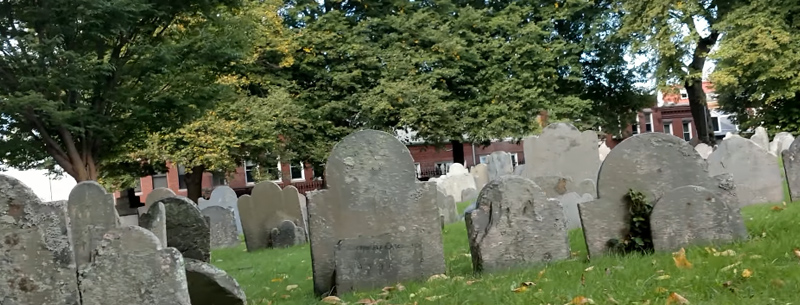
Today, Copp’s Hill Burying Ground is a popular tourist destination, attracting visitors from all over the world. It offers insight into the early history of Boston and serves as a reminder of how far our nation has come since those tumultuous times. As one strolls through this picturesque place, they can’t help but be awed by the solemn yet fascinating atmosphere that permeates the area. Copp’s Hill Burying Ground truly serves to remind us all of our past, and of what it means to be free.
USS Constitution
The U.S.S. Constitution is the world’s oldest commissioned warship and is a jaw-dropping 221 years old – and is still sailing today. As one of the most iconic symbols of American History, the USS Constitution is a must-see along the Boston Freedom Trail. Originally christened in 1797, it was designed by Joshua Humphreys and was the first warship launched under the US Navy.
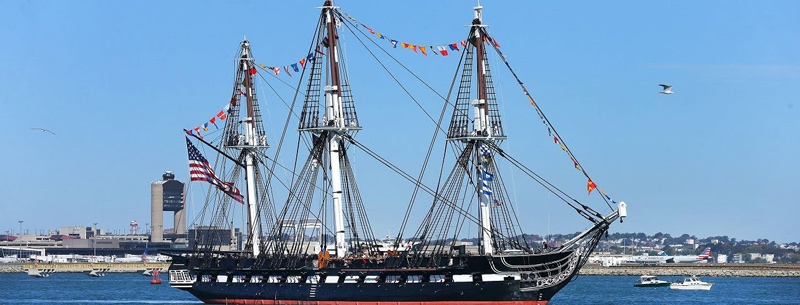
The ship fought in numerous battles during the War of 1812 and even defeated five British warships, earning its nickname “Old Ironsides” for its seemingly bulletproof hull. Today, visitors can explore the decks of this floating museum and relive history as they take in the sights and sounds of a bygone era. Guests can also participate in activities such as mast climbing and cannon firings to get a true sense of what life on the seas was like two centuries ago. No matter which site you visit along the trail, make sure you don’t miss out on the chance to experience the USS Constitution.
History of the Boston Freedom Trail
The Boston Freedom Trail was established in 1951 by Bill Schofield, a writer for the Herald Traveler newspaper who had been frustrated at his inability to easily locate Boston’s famous historical sites. Using his newspaper column to propose and market the idea, Schofield quickly found success when his idea was picked up by city officials who recognized the value the trail would bring to city dwellers and tourists alike. Schofield became known as the Father of the Freedom Trail. To this day, the Freedom Trail remains one of Boston’s most popular attractions and a worthwhile trek through the city’s historical sites.
FAQs about the Freedom Trail Boston
How long does it take to walk Freedom Trail?
The Freedom Trail is a 2.5-mile route that typically takes about two hours to complete, with ample time for stops at various sites along the way.
What is so special about the Freedom Trail?
The Freedom Trail is unique in that it leads visitors through 16 of Boston’s most historic sites, each one offering a window into the country’s past and role in the fight for freedom. From Paul Revere’s house and The Old North Church to the USS Constitution and Bunker Hill Monument, the trail offers an unforgettable journey into the heart of Boston’s rich history.
Is the Freedom Trail good?
The Freedom Trail has been given accolades from both locals and tourists alike as being an essential part of any visit to Boston. Whether you’re looking for an enjoyable afternoon outing or an educational experience, the Freedom Trail delivers.
Is the USS Constitution part of the Freedom Trail?
Absolutely! Visiting The USS Constitution Museum is one of sixteen stops along the Freedom Trail, and provides a glimpse into how naval warfare evolved during the Revolutionary War and beyond.
Can I walk Freedom Trail by myself?
Absolutely! You can navigate the trail on your own using a map or pamphlets available online or at local tourist spots. Or, if you’re looking for a more immersive experience, there are guided tours available from various companies that offer behind-the-scenes stories and expert commentary on each stop along the trail.
Can you walk the Freedom Trail without a tour?
Yes! While guided tours are a great way to get an in-depth look at Boston’s history, you can also explore the Freedom Trail at your own pace. Pick up a pamphlet or download a map from the official website to find your way through the 16 historic stops.
Where is the best place to start the Freedom Trail?
The best place to begin your journey is at the Visitor Information Center located near Faneuil Hall Marketplace in downtown Boston. Here you can pick up a map or join a guided tour.
Do you have to pay to go on Freedom Trail in Boston?
No, admission to all attractions along the trail is free; however some attractions may charge a small fee for entry.
Is there a free Freedom Trail app?
Yes! The official ‘Boston Freedom Trail’ app is available for free on Android and iOS devices and provides maps, audio tours, and historical information about each site along the trail.
How many stops are there on the Freedom Trail?
The Freedom Trail comprises 16 different stops throughout Boston, ranging from churches and graveyards to monuments and national landmarks.
Is the Boston Tea Party on the Freedom Trail?
Absolutely! The original Tea Party happened right on Griffin’s Wharf, which can be found just steps away from Paul Revere House, making it one of many iconic stops along the Freedom Trail.
How many stops are there on the Freedom Trail in Boston?
There are 16 stops along the route, beginning at Boston Common and ending at Bunker Hill Monument in Charlestown Navy Yard.
Is the Freedom Trail easy to follow?
Yes! The route is clearly marked with red lines and brick pavers embedded in the sidewalks along the trail, making it very easy to navigate even when exploring on your own.
What is the closest station to the Freedom Trail?
The closest T Station to the Freedom Trail is Park Street Station, located just steps away from Boston Common, which marks the official starting point of the Freedom Trail.
What does the Freedom Trail include?
The Freedom Trail includes 16 iconic sites including Paul Revere House, Old South Meeting House, Faneuil Hall Marketplace, USS Constitution Museum, Bunker Hill Monument and much more!
Final Word
I didn’t quite manage all 16 of the historic sites on the Freedom Trail. So next time I visit Boston, as there will most definitely be one, I will need to make sure I finish seeing all the sites on the Freedom Trail. If you love a city, I always find it’s worth leaving something for a future visit, that way there is always a reason to return.
If you’ve visited Boston, did you walk the Freedom Trail?
